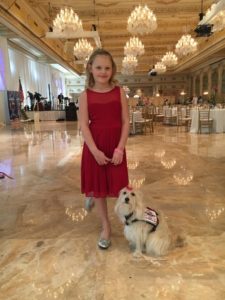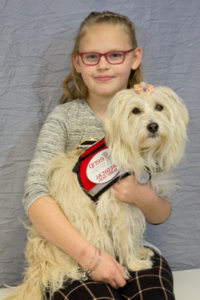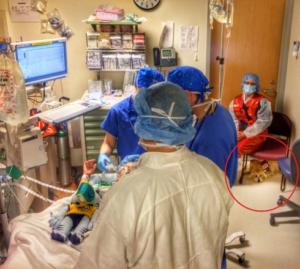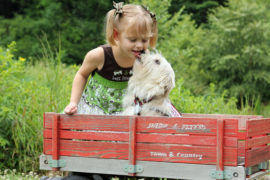A Dog with Wings: The Story of KK and her ‘Angel’: Medical Alert Dog JJ
By Janis Gioia
Allergic to Anything
Mythology is full of stories about animals with wings.
Pegasus, the winged horse.
The Simargl, of East Slavic mythology, is a winged dog revered for being agile, quick, strong and intelligent.
KK of North Carolina has a real dog with wings.
Angel wings. (And angel paws, and an angel nose.)
JJ, a beautiful long-haired terrier mix, is KK’s medical alert service dog, protector and lifesaver. Like the simargl of yore, JJ is quick and intelligent.
She’s also earned her angel wings many times over.
KK (now 10) was born with mastocytosis, a rare illness that causes her to have allergic reactions that can progress rapidly to anaphylactic shock, which is life-threatening.
 But unlike most people who know what they are allergic to (bees, food, pollen, etc.) KK’s allergic reactions are triggered by multiple everyday things like foods, changes in temperature, exercise, chemicals, friction on her skin, the beginnings of an illness or infection, medications, stress.
But unlike most people who know what they are allergic to (bees, food, pollen, etc.) KK’s allergic reactions are triggered by multiple everyday things like foods, changes in temperature, exercise, chemicals, friction on her skin, the beginnings of an illness or infection, medications, stress.
Anything and everything can potentially become a trigger for KK, and often with no warning.
Michelle, KK’s mom, says, “KK can have a reaction by doing things kids do: playing Wii Fit, taking a bath, watching TV, or going to the movies.”
“KK has mild allergic reactions every day. Sometimes these reactions can be seen in the mastocytosis “spots” (lightly colored lesions) always visible on her skin. During a reaction these spots will sometimes become hives, which is a visible sign that an allergic reaction is occurring.”
“Unfortunately,” Michelle continues, “there is not always a visible sign to alert us. When a reaction occurs, without warning and with no apparent trigger, it can be severe, rapid and potentially fatal.”
While taking daily preventative medicines helps, it isn’t always enough. When they know what the trigger is they can make changes to hopefully ward off a reaction.
“For example,” Michelle explains, “if she is playing with her siblings and getting overheated, and I see a reaction starting, I can have her sit, calm down, and try to stop the reaction from progressing.”
“If that doesn’t work, we have “rescue” medications that can be administered to help prevent the reaction from going into anaphylactic shock.”
Because of the severity of the allergic reactions, which can cause irritability, vomiting, and a severe drop in blood pressure that can lead to loss of consciousness. KK needed to have her mom or dad with her at all times.
“We have a big golden doodle, Nixon. One day I thought, “Wouldn’t it be great if Nixon could watch over her? Michelle smiles, “Of course Nixon, as awesome as he is, wasn’t the right dog for KK. But I knew a service dog was the answer.”
Canines for Disabled Kids

“I was excited about the idea of having a service dog to watch over KK, and get help for her if necessary. But unfortunately, no service dog organizations would take us. I called everyone I could think of, throughout the country.”
“They all said they didn’t train dogs for that condition, or that KK was too young. We were struggling to make a positive connection.”
Until she left a message for Kristin Hartness with Canines for Disabled Kids.
“I was simultaneously talking to the organization that trained JJ (Eyes Ears Nose and Paws) when Kristin contacted me.”
Michelle says that Canines for Disabled Kids provided her with invaluable support by recommending service dog providers, confirming her trust in the organization they selected (EENP), providing a scholarship for helping them obtain JJ, and educating Michelle and KK’s school on working with a medical alert service dog.
From Rescued to Rescuer
JJ has come a long way from being left abandoned in a “pet drop off” box at the Orange County Animal Shelter.
Discarded as a puppy, trainer Deb Cunningham, an expert in scent detection, knew that JJ (named prior to being matched with KK) was a diamond in the rough.
Deb says, “I knew JJ was a good dog to train because not only was she good at scent work, as most dogs are, but she was very willing to communicate and alert to scents. Some dogs will identify a scent, and then go play ball. JJ is an extrovert…she is very communicative, and that’s what you need in a medical alert dog.”
“When Deb told me that there was a smell related to KK’s reactions, I honestly thought she was crazy,” Michelle laughs. “But I didn’t have anything to lose. So I did what she asked…I swabbed KK’s mouth after she had a reaction and gave her the clothes that KK was wearing at the time.”
Sure enough, Deb was right. Like medic alert dogs who use scent to detect epileptic seizures, drops in blood sugar in someone with diabetes or changes in blood pressure that lead to syncope (fainting), JJ could detect an allergic reaction as it was starting, before it became severe.
“Before we had JJ, KK would have an anaphylactic reaction 3-4 times a year. Now she’s only had three in the past 5 years, “Michelle explains. “This is because JJ smells the chemical change at the onset, before it becomes severe.”
JJ’s capabilities at home were a tremendous help for the family, but what Michelle really wanted was for KK to go to school and have as regular a childhood as possible.
Off To School
For parents of children with life-threatening medical conditions, sending their child off to school is anything but routine.
“Canines for Disabled Kids was a huge help when KK and JJ started going to school together,” says Michelle. “Kristin was instrumental in helping me navigate the school system.”
“Kristin told me what to expect, what the law would support, and what we should and shouldn’t expect the school to do.”
Kristin Hartness, Executive Director of Canines for Kids provided Michelle with information on educating KK’s school about service dogs.
“We discussed that most facilitators are the parents or custodial adults,” says Kristin. “We talked about what facilitation means and the restrictions that come with it (no facilitator – no dog). We talked about the school’s right not to provide a facilitator and that not all training programs will allow additional facilitators.”
“Michelle was able to use the information we had discussed and communicate it with the school for successful use of JJ under her facilitation at school. While some parents aren’t able to do this, Michelle’s work schedule allowed for it.”
 “I provided letters for the school to use when they communicated with other parents to assure the school stayed within federal law when discussing a service dog attending school. I also sent a letter the family could use with the local police to make them aware that KK has a service dog and direct them to resources about the ADA’s rules on service dogs,” Kristin concludes.
“I provided letters for the school to use when they communicated with other parents to assure the school stayed within federal law when discussing a service dog attending school. I also sent a letter the family could use with the local police to make them aware that KK has a service dog and direct them to resources about the ADA’s rules on service dogs,” Kristin concludes.
As time has gone by, KK has gradually taken over and is now JJ’s handler.
KK goes to school for half a day and is home schooled for the other half. While KK is in school, Michelle is on the school campus, with a walkie-talkie. She is no longer required to stay in KK’s classroom.
All part of the family’s plan to allow KK to live her life as independently as possible.
In the Operating Room
Medical service dogs aren’t an anomaly, but having one go into an operating room to monitor a patient, in addition to multi-million dollar machines, is pretty unique.
Michelle laughs, “JJ and KK made international news when KK’s surgical team (at Duke University) requested that JJ accompany KK into the operating room. Anesthesia is high risk for anyone, but especially a patient with mastocytosis.”
 “The doctors thought JJ might be able to detect KK’s reactions quicker than medical equipment during a procedure that would not need the environment to be completely sterile.”
“The doctors thought JJ might be able to detect KK’s reactions quicker than medical equipment during a procedure that would not need the environment to be completely sterile.”
“In addition to being there to monitor KK’s reactions, JJ also provided KK with comfort, which, for a child with mastocytoisis undergoing a surgical procedure, is invaluable. Since stress can make her condition worse, having JJ in the room makes everyone a lot more relaxed…KK, us, and the doctors.”
Her feats at Duke have led JJ to become somewhat of a celebrity in the service dog world.
JJ and KK have been featured on The Today Show, ABC News with Diane Sawyer, Fox, CNN, and NBC. Their inspirational story has been shared on every continent and translated into many languages. JJ was also the 2014 American Humane Association Service Dog of the Year.
Not bad for a dog left abandoned at a shelter.
Pint-Sized Inspiration
In addition to being a superstar and KK’s best friend, JJ has inspired KK, even at a young age, to a life of service.
“KK has become an incredible advocate for service dogs and responsible pet ownership,” says Michelle. “She organizes food donation drives at her school to benefit the shelter that rescued JJ. She is the North Carolina ambassador for Kids against Animal Cruelty and has spoken to schools, camps and Girl Scout groups about the role of service dogs and how to respond to them in public.”
KK plans to become a veterinarian and provide free care for service dogs.
For now KK is content to play the piano, do an art project or go swimming, always with her guardian angel by her side.
Michelle is grateful to Canine for Disabled Kids for helping her bring this miracle dog into their lives.
After all, not many children have a dog with wings.
~ Janis Gioia special education teacher who writes for organizations supporting children and adults with disabilities and mental health challenges.
JJ was the recipient of the American Humane Society Hero dog Award. Check it out here! – Link
KK and JJ’s Facebook Page – https://www.facebook.com/AngelPawsforKK
“EENP Client Kaelyn (KK) had a planned surgery on December 18th, 2013 at Duke Medical Center. KK is a seven-year-old girl who has a very rare condition called mastocytosis that causes her to have “reactions” that range from mild to severe anaphylaxis. Anesthesia and a medication that might be needed during the surgical procedure are both known triggers for KK’s reactions.
There is no medical technology to anticipate these reactions; rather, the medical team simply has to respond to changes in KK’s vital signs once the reaction is under way. These reactions can quickly become life-threatening, and as KK’s anesthesiologist, Dr. Brad Taicher, pointed out, “we don’t want to wait till KK has a problem to treat it – we want all the warning we can have.” JJ had convinced KK’s medical team that she could detect KK’s reactions long before their equipment could when, on a previous hospital visit, JJ alerted KK’s mom to a reaction five minutes before any of KK’s vital signs changed.
Dr. Taicher requested that JJ be in the procedure room for the surgery because he felt she was the most sensitive technology available to him to detect KK’s reactions. Taicher explained, “It sounds silly, in this age of technology, when we have millions of dollars worth of equipment beeping around me, that we had a little dog who was more sensitive than all the machines.” If JJ could give them even a minute of advance warning that KK was about to have a major change in condition, it could make a huge difference in the outcome.
It is an understatement to say that it is highly unusual to have a dog invited to be present for surgery at a major medical center — it may well be unprecedented — but KK’s medical team felt that the risk of having a dog in the procedure room would be far outweighed by the benefit of having early detection of a reaction during the surgery.
On December 18th, JJ accompanied KK into the procedure room for her surgery, and made history. The surgery went very well, and KK only had one minor reaction as she came out of anesthesia. Please watch and read some of the great coverage of this historic event. There is more background on KK’s and JJ’s partnership below the links.” – Shared from Ears, Eyes, Nose and Paws.
Other media outlets with stories about KK and JJ
- ABC World News Tonight with Diane Sawyer: link
- Inside Edition: transcript of 1/8/14 broadcast
- Inside Edition: bonus footage
- Yahoo! News: link
- ABC national website – link
- NBC national website – video: link
- Today (NBC) website: link
- CBS News: link
- CNN: link
- News & Observer – article: link
- News & Observer – 10 photos: link
- WNCN (NBC) – these are the first NBC stories (two news clips and written story): link
- WTVD (ABC) – this is the first ABC story (video and written story): link
- FoxNews.com: link
- The Huffington Post: link
- Talk 910 San Francisco – radio interview with JJ’s trainer, Deb Cunningham: link
- Bustle: link
- The Chronicle (Duke): link
- Duke’s website: link
- American Veterinary Medical Association (AVMA): link
- Health Newsline: link
- TaleMed (Talent for Medicine): link
- EMSWorld: link
- Dog Heirs: link
- Orvis News: link
- I Love Dogs: link
- Growing Your Baby: link
Video featuring KK and JJ on the ABC Nightly News!
KK and JJ – Medical Alert Dogs












